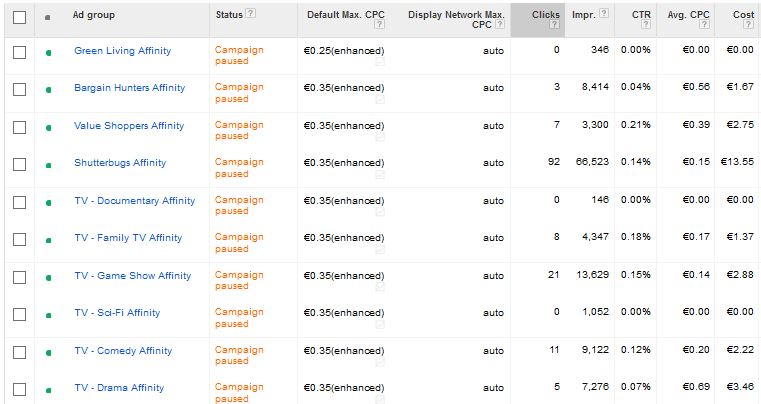The Google Display Network is a great resource to have in the armoury for any digital marketer. The GDN has a dual branding and direct response function within the marketing mix. What I mean by brand is awareness and intent stimulation as opposed to direct response which is more purchase/action.
There are numerous targeting methods available in the Google Display Network including contextual keywords, topics, interests, remarketing lists and demographic targeting. Each of these deserves their own blog post, this post is only concerned with broad targeting options, ie. topics & interest targeting.
The GDN (including YouTube) sits quite comfortably in the world of traditional advertising, ie. TV, print, radio. This is a channel that disrupts the audiences’ activity with a brand or product message in order to make them aware of the advertiser’s offering. Like traditional advertising, audiences & media are chosen based on the likelihood of a positive reception to this message. Audience choice can be informed by market research, historical/seasonal data or by vertical insight. Either way, the audience isn’t looking for the brand or product so you will notice a different level of response metrics and behaviour to what would normally be seen in other online channels, eg. search advertising.
The point of difference between these two broad online channels, ie. search & display, is that searchers are looking for something while display audiences may not be ‘in the market’ just yet.
So Why Do Display Advertising?
If search can deliver superior ROI and on one hand appears to be better value to display, why would we even bother with display? The answer is intent. Searchers don’t suddenly wake up one morning and look for a product, service or brand that they’ve never heard of before. Search is powered by the world of intent but it is also confined by it too.
Essentially we need stimulus activity to help drive search intent, otherwise advertisers are limited to the natural search intent for their product or brand. Ok if you’re a big established brand you can leverage the knowledge of your audience to drive your search. But what if you have a new product or are indeed a new brand? What then? If you have a new USP then people need to know about this to fuel your search activity and influence search volumes through awareness.
But Display Isn’t Just About Creating Intent
While I am an advocate of display campaigns to let people know about your offering, it is not simply confined to this. Performance display is a way of directly increasing the ROI of your stimulation activities by marrying them with conversion-focused goals.
In the traditional model, CPMs hid the truth about display. A CPC model is a far more effective pricing structure in terms of true engagement and brand interaction. Display ads served on a CPM model serve no-one’s interests but the media owner. If an impression is served below the fold the advertiser still pays. This is not performance marketing. When someone clicks, at least we know that they interacted with the ad. Even if they clicked by mistake, all is not lost. A small percentage of visitors could be convinced by the website, especially if we consider that they are within the target audience and therefore should be open to the advertiser’s offering.
Approaching Display Like Search
In order to get the best out of Google Display campaigns, I tend to approach them like I would any paid search activity, working backwards from the lowest level. In search I work backwards by keyword to create ad group themes and then campaign themes. Google Display should be no different. However, when using topics or interest targeting, there are no keywords. This is where ad group management comes into the mix.
- Put one interest/topic per ad group. This keeps everything tight and allows you to quickly see how each target is doing at an ad group level. If you mix targets one target maybe performing well and others may be performing poorly, so at first glance at an ad group level, everything appears to be doing badly. Keep them separate, it’s a bit of extra work but it’s well worth it.

- Group interest ad group themes in interest campaigns, put topics in topic themed campaigns.
- Like in search, keep your high volume targets in their own campaign to manage daily budgets more effectively. Keep news and other high-volume topics & interest campaigns separate from more specific targeting.
Think of Targets like Keywords.
Now that the structure is set up to effectively communicate with your desired audience, let the campaigns loose into the world to see how they perform. Unfortunately there is no definitive science to this. The campaign is built to best practice to match an audience profile as determined by the brief and the rest is done by Google’s topic & interest target groups. However we will soon see what’s working and what’s not.
After 1-2 weeks, it is advisable to pause any ad groups with no clicks as these are obviously not working as a targeting selection or someone would have clicked. Again using clicks (interactions) rather than impressions as a measure of success.
The next area to look at are the placements themselves. in the placements section within the AdWords Display Network tab you’ll see a list of every website the ads have been served on. Think of these as your keywords. Pause or Exclude (you can exclude at ad group level because each target has its own ad group, don’t recommend excluding at a campaign level as a placement might be performing well in another ad group within that campaign) placements that are under performing in terms of clicks or conversions.
By excluding poorly performing placements from your topics & interests targeting you can enhance the performance of those websites which deliver on your conversion KPIs. Bid up on placements which convert at an acceptable CPA and pull bids back or pause/exclude those with an overly expensive CPA.
Summary
By following this methodology you can drag broad targeted Google Display advertising kicking and screaming into the world of performance advertising. What’s more, display should not just be seen as an awareness tool but also one that directly contributes, in a positive way, to the overall ROAS of the campaign.
While display will never have the same direct response ROI impact as search advertising (we just have to make our peace with this) it does serve as an important tool within the digital marketing mix.
Furthermore, there have been a number of advances in direct response display in the world of ecommerce. The use of feed managed display retargeting like Criteo or more recently Google’s Dynamic Product Retargeting display provides up-to-date price specific visual ads retargeted to those who are most likely to buy.
So gone are the days of smokescreens and CPMs. Performance display is all about measurable returns in terms of blended direct response and awareness, ie. how activity influences other channels to perform and this is how display campaigns should be evaluated.
And then there’s Google Shopping..

